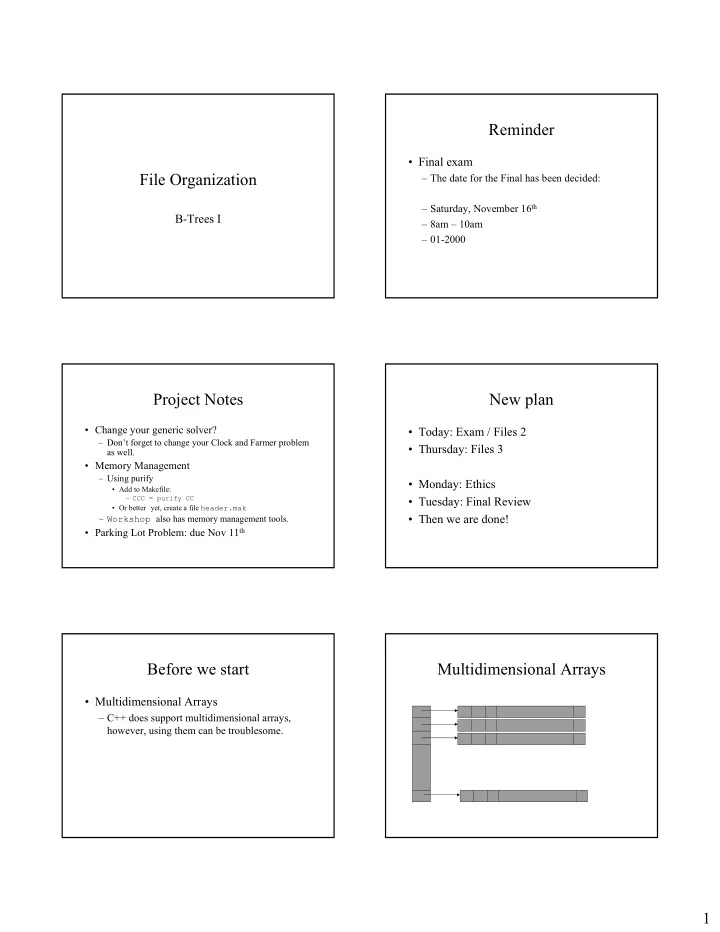

Reminder • Final exam File Organization – The date for the Final has been decided: – Saturday, November 16 th B-Trees I – 8am – 10am – 01-2000 Project Notes New plan • Change your generic solver? • Today: Exam / Files 2 – Don’t forget to change your Clock and Farmer problem • Thursday: Files 3 as well. • Memory Management – Using purify • Monday: Ethics • Add to Makefile: – CCC = purify CC • Tuesday: Final Review • Or better yet, create a file header.mak • Then we are done! – Workshop also has memory management tools. • Parking Lot Problem: due Nov 11 th Before we start Multidimensional Arrays • Multidimensional Arrays – C++ does support multidimensional arrays, however, using them can be troublesome. 1
Multidimensional Arrays Multidimensional Arrays • Ways to declare • C++ does support int **foo; // array of pointers to int – int [20][10] foo = new int * [20]; for (i = 0; i < 20; i++) foo[i] = new int [10]; – However, dimensions must be known at compile time. foo[3][5] is the same as (foo[3])[5] – Must pass at least 1 dimension when passing to functions. Must delete each foo[i] when done. Multidimensional Arrays Before we start • Using vectors or deques • Any questions using namespace std; typedef deque<int> Decker ; typedef deque<Decker> DoubleDecker ; int main (int argc, char *argv[]) { Decker D (10); DoubleDecker DD (20, D); DD[3][4] = 10; } File Organization Going up a level • How to find stuff in a file • The OS must also: – Improve access time by imposing a defined – Organize it’s file system for maximum structure on a file performance (I.e. low access time) – Database applications – File System – Advanced searching strategies • If the file is a searchable database – This optimization can be improved by imposing an additional structure on a file. 2
Terminology Organization Strategies • Record • Sequential – Collection of data pertaining to one entity • Indexed • E.g. Employee • Hashing – Each record consists of a number of data fields. • Tree-based Organization – Files are composed of a collection of records. • Key – Field within a record upon which a search is made Recall from CS2 Binary Search Trees • Binary Search Tree • Branching can also imply ordering of node data – Efficient storage for search / retrieval of “sortable” data. 45 – Basic idea > < • Left subtree contains nodes with data less than data at node 30 55 • Right subtree contains nodes with data greater than < > > < data at node 22 35 50 60 All values less than 45 All values greater than 45 Binary Search Trees Binary Search Trees • Searches using binary trees can be done in • Balanced trees O(log n) time. – A binary tree is perfectly balanced if the number of nodes in the left and right subtrees is no more than 1 for • However, to achieve this, trees must be each node. balanced. • Difficult to insert into a perfectly balanced tree and maintain it’s “perfect” status – Consider: – A binary tree is height balanced if the height of the left and right subtrees of every node (at each level) differs by no more than one. • Height balancing is easier to achieve than perfect balancing 3
Binary Search Trees Multiway Search Trees • A generalization of binary search trees • Each node has at most m children • If a node has k children, it has k-1 keys • The tree is ordered Multiway Search Trees B-trees • A B-Tree (of order m) is a multiway search tree with: – All leaves at the same level – Each interior node has between m and m/2 non- empty children – Each leaf node holds between m/2 to m - 1 keys – The root has between 2 and m non-empty children B-Trees (order 3) B-trees • For simplicity we say nodes have pointers and keys. • Since they are to used for file indexing: – Nodes contain key / file location pairs – Trees are sorted on key values. 4
We’ll stop here • Thursday: – B-Tree insertion and deletion 5
Recommend
More recommend